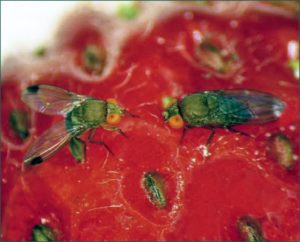Drosophila, Spotted Wing
Latin name: Drosophila suzukii (photo is courtesy of Beverly Gerdeman, PhD, Washington State University)
Size: Less than 1/8″ long
Color: Spotted Wing Drosophilas are small fruit flies that have red eyes, clear wings and a yellow-brown body color. The male has a single black spot on the end of his wings and two black “combs” on front legs. The female does not have the black spots or combs, so they can be challenging to identify.
Life cycle: The female Spotted Wing Drosophilas use their razor-sharp ovipositor to insert eggs into the fruit. They can lay up to 350 eggs in their short 3-4 week lifespan! There will be tiny hairs attached to the eggs which allows them to breathe. The white larvae/maggots then hatch, tunnel through the fruit and feed upon them. The larvae go through 3 instars (stages) before pupating. They they emerge as an adult to begin the cycle all over again.
Symptoms of their activity: Ruined fruit containing small maggots, fruit flies in area.
Typically seen on: Tree fruits such as cherries, peaches and plums; grapes; berry crops such as strawberries, blueberries, blackberries and raspberries.
Controls: Monitor for the adult flies by making simple traps that contain apple cider vinegar with a drop of dish detergent in it. Here is a link to information on how to make and position the traps, as well as more in-depth information about the SWD: http://cru.cahe.wsu.edu/CEPublications/FS049E/FS049E.pdf. If you see fruit flies matching the above description in your trap, take them to your local Master Gardener program for more positive identification and also to notify them that SWDs are active in your area. Research is being conducted for the best (and safest) methods for controlling SWDs.
Cultural controls: Clean up all dropped or remaining tree fruits or berries from your orchard and garden. Discard the fruit, rather than composting it.
Natural predators: Parasitic wasps.
Additional information: Washington State University Spotted Wing Drosophila, Michigan State University Spotted Wing Drosophila and Oregon State University Spotted Wing Drosophila Project.
Back to Organic Pest Control

